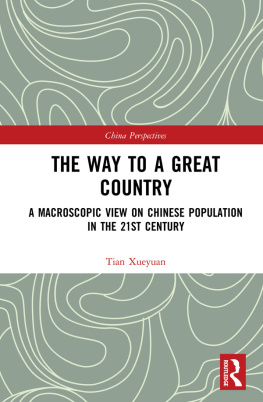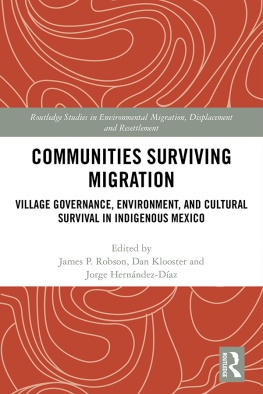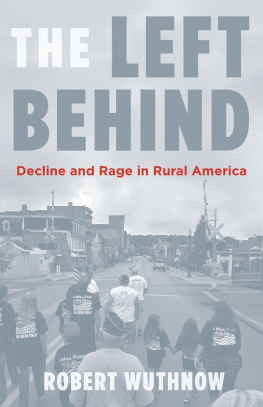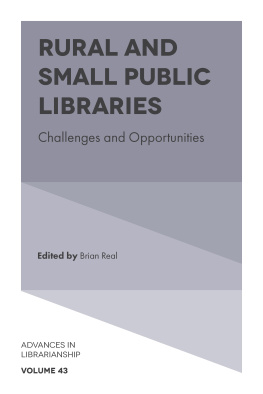
The Impact of Population Change on Business Activity in Rural America
Other Titles in This Series
Rural Public Services: International Comparisons, edited by Richard E. Lonsdale and Gyrgy Enyedi
The Social Consequences and Challenges of New Agricultural Technologies, edited by Gigi M. Berardi and Charles C. Geisler
Rural Society in the U.S.: Issues for the 1980s, Don A. Dillman and Daryl J. Hobbs
Technology and Social Change in Rural Areas: A Festschrift for Eugene A. Wilkening, edited by Gene F. Summers
Science, Agriculture, and the Politics of Research, Lawrence Busch and William B. Lacy
The Cooperative Extension Service: A National Assessment, Paul D. Warner and James A. Christenson
The Organization of Work in Rural and Urban Labor Markets, Patrick M. Horan and Charles M. Tolbert II
Available in hardcover and paperback.
Rural Studies Series
The impact of Population Change on Business Activity in Rural America
Kenneth N. Johnson
Dr. Johnson moves beyond the existing literature on rural-urban population shifts during the past forty years to examine the effects of those shifts on the business infrastructure that supplies goods and services to rural areas in the United States. First establishing a historical demographic context to serve as a backdrop, he provides a detailed longitudinal treatment on the linkage between population change and the rural commercial infrastructure, as well as timely information on the impact of the recent rural population turnaround on business. Some of his findings, based on the latest data available, refute earlier expectations that a decrease in population necessarily leads to a decline in the local business community.
Kenneth M. Johnson is an associate professor in the Department of Sociology at Loyola University of Chicago, where he teaches courses in demography, research methods, and statistics. Most of his research has focused on nonmetropolitan demographic trends and their impact on the local economic and organizational structure. Dr. Johnson is also a principal member of the Applied Demographic Research Group, which does demographic consulting for large corporations, including McDonalds and Budget Rent a Car.
The Rural Studies Series of the Rural Sociological Society
Editorial Board
Chairman, David L. Brown, ERS, USDA, Washington, D.C.
Jere L. Gilles, University of Missouri
Denton E. Morrison, Michigan State University
Sonya Salamon, University of Illinois
Marta Tienda, University of Wisconsin
Kenneth P. Wilkinson, Pennsylvania State University
James J. Zuiches, Cornell University
First published 1985 by Westview Press
Published 2019 by Routledge
52 Vanderbilt Avenue, New York, NY 10017
2 Park Square, Milton Park, Abingdon, Oxon OX14 4RN
Routledge is an imprint of the Taylor & Francis Group, an informa business
Copyright 1985 the Rural Sociological Society
All rights reserved. No part of this book may be reprinted or reproduced or utilised in any form or by any electronic, mechanical, or other means, now known or hereafter invented, including photocopying and recording, or in any information storage or retrieval system, without permission in writing from the publishers.
Notice:
Product or corporate names may be trademarks or registered trademarks, and are used only for identification and explanation without intent to infringe.
Library of Congress Cataloging in Publication Data
Johnson, Kenneth M. (Kenneth Michael), 1950-
The impact of population change on business activity
in rural America.
(Rural studies series / sponsored by the Rural
Sociological Society)
Includes bibliographies and index.
1. United StatesPopulation, Rural. 2. Store
locationUnited States. 3. Retail tradeUnited
StatesLocation. I. Title. II. Series: Rural studies
series of the Rural Sociological Society.
HB2385.J64 1985 381.10973 84-26962
ISBN 13: 978-0-367-29299-7 (hbk)
To Brenda
This book examines the implications of population change for the organization of business activity in the rural United States. Its main contribution lies in its examination of a complex set of linkages between population change on the one hand, and the commercial organization of rural society on the other over an extended period of history. It is an example of how demographic research can be applied to real-life situations in a broad societal context.
The book is rooted in sociological human ecology, a basic tenet of which is that population change cannot occur for any significant period of time without resultant adjustments in the social organization of society. Dr. Johnson attempts to explain not only the mechanisms of this process but also its implications.
The research reported here focuses on three main issues: (1) What is the historical pattern of demographic change in the rural United States? (2) How have these demographic shifts influenced business infrastructure? (3) How has the historical linkage between population change and business change been affected by the recent population turnaround in the rural United States? The research demonstrates that population change does have a significant impact on local business activity, but the linkage is complex and adjustment is accomplished only after a considerable length of time. The research also shows that the recent resurgence of rural population growth has stimulated a business renaissance. In fact, some rural communities now have business growth rates that equal or exceed those in metropolitan areas.
Demographers will find this study of significant value because of its focus on the consequences of population change and its application of the human ecological perspective. Rural researchers will find the specific focus on business infrastructure and activity an important adjunct to broader work that has been done on rural demographic and economic change. And business planners will gain insights into the vast and expanding market for goods and services that continues to exist outside of metropolitan areas in small towns and villages and in the open country.
David L Brown
Chairman, Board of Editors
Rural Studies Series
Nonmetropolitan areas of the United States have changed a great deal in the sixty years spanned by this research. In 1920, half the population resided in areas now considered nonmetropolitan, but in the following years millions left, attracted by the economic and social opportunities of the nations urban centers. By 1970, less than a quarter of the population lived in nonmetropolitan areas. The rural-to-urban migration stream that underlay this phenomenon was among the most enduring trends of U.S. demographic history. Yet the final decade of this study witnessed a remarkable population renaissance in nonmetropolitan areas. Counties with long histories of population decline began to grow, and nonmetropolitan growth rates exceeded those in metropolitan areas for the first time in at least a century. Scholars understand many of the reasons for the protracted nonmetropolitan decline and have some idea of the causes of the recent nonmetropolitan turnaround. What is not well understood is the long-term consequences such population trends have for the organizational structure serving nonmetropolitan residents.







